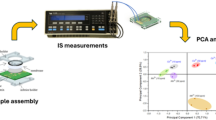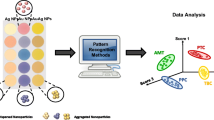Abstract
A robust multi-dimensional sensing array based on VBimBF4B/MAA-anchored quantum dot (QD)-grafted covalent organic frameworks (COFs) [(V-M)/QD-grafted COFs] was established via one-pot strategy. The multi-dimensional sensing array has the outstanding advantages of physicochemical and thermal stability, large specific surface area, and regular pore structures. The assistance of ionic liquid VBimBF4B enhanced the transduction efficiency, and the synergistic effect of COFs enhanced detection efficiency. The improved multi-dimensional sensing array by COFs and ionic liquid VBimBF4B served to identify seven insecticides by non-specific interactions via hydrogen bonding, and the differences in the kinetics of the binding to the insecticides resulted in variation of the three-output channel (fluorescence, phosphorescence, and light scattering) signals, thus generating a distinct optical fingerprint. The unique fingerprint patterns of seven kinds of common insecticides at 200 μg L−1 were successfully discriminated using principal component analysis and clustered heat map analysis. The multi-dimensional sensing array showed a response to seven insecticides based on three spectral channels over the range of 0.001–0.4 μg mL−1 with a limit of detection of 1.08–18.68 μg L−1. The spiked recovery of tap water was 79.86–134.22%, with RSD ranging from 0.89–14.9%. This study broadens the applications of sensing arrays technology and provides a promising building block for insecticide determination.
Graphical abstract







Similar content being viewed by others
References
Resch-Genger U, Grabolle M, Cavaliere-Jaricot S, Nitschke R, Nann T (2008) Quantum dots versus organic dyes as fluorescent labels. Nat Methods 5(9):763–775. https://doi.org/10.1038/nmeth.1248
Bruchez M, Moronne M, Gin P, Weiss S, Alivisatos AP (1998) Semiconductor nanocrystals as fluorescent biological labels. Science 281(5385):2013–2016. https://doi.org/10.1126/science.281.5385.2013
Colvin VL, Schlamp MC, Alivisatos AP (1994) Light-emitting diodes made from cadmium selenide nanocrystals and a semiconducting polymer. Nature 370(6488):354–357. https://doi.org/10.1038/370354a0
Chen J, Zheng J, Zhao K, Deng A, Li J (2020) Electrochemiluminescence resonance energy transfer system between non-toxic SnS2 quantum dots and ultrathin Ag@Au nanosheets for chloramphenicol detection. Chem Eng J 392:123670. https://doi.org/10.1016/j.cej.2019.123670
Côté AP, Benin AI, Ockwig NW, Keeffe M, Matzger AJ, Yaghi OM (2005) Porous, crystalline, covalent organic frameworks. Science 310(5751):1166–1170. https://doi.org/10.1126/science.1120411
Ni T, Zhang D, Wang J, Wang S, Liu H, Sun B (2018) Grafting of quantum dots on covalent organic frameworks via a reverse microemulsion for highly selective and sensitive protein optosensing. Sensors Actuators B Chem 269:340–345. https://doi.org/10.1016/j.snb.2018.04.172
Shet SM, Bisht M, Pramanik S, Roy S, Kumar TS, Nataraj SK, Mondal D, Bhandari S (2020) Engineering quantum dots with ionic liquid: a multifunctional white light emitting hydrogel for enzyme packaging. Adv Opt Mater 8(8):1902022. https://doi.org/10.1002/adom.201902022
Qian S, Sun S, Wang Y, Li Z, Lin H (2019) Recent advances of multidimensional sensing: from design to applications. Sci China Chem 62(12):1601–1618. https://doi.org/10.1007/s11426-019-9585-5
Li X, Kong C, Chen Z (2019) Colorimetric sensor arrays for antioxidant discrimination based on the inhibition of the oxidation reaction between 3,3′,5,5′-tetramethylbenzidine and hydrogen peroxides. ACS Appl Mater Interfaces 11(9):9504–9509. https://doi.org/10.1021/acsami.8b18548
Ngernpimai S, Geng Y, Makabenta JM, Landis RF, Keshri P, Gupta A, Li CH, Chompoosor A, Rotello VM (2019) Rapid identification of biofilms using a robust multichannel polymer sensor array. ACS Appl Mater Interfaces 11(12):11202–11208. https://doi.org/10.1021/acsami.9b00839
Das Saha N, Sasmal R, Meethal SK, Vats S, Gopinathan PV, Jash O, Manjithaya R, Gagey-Eilstein N, Agasti SS (2019) Multichannel DNA sensor array fingerprints cell states and identifies pharmacological effectors of catabolic processes. ACS Sens 4(12):3124–3132. https://doi.org/10.1021/acssensors.9b01009
Yang J, Yang T, Wang X, Wang Y, Liu M, Chen M, Yu Y, Wang J (2019) A novel three-dimensional nanosensing array for the discrimination of sulfur-containing species and sulfur bacteria. Anal Chem 91(9):6012–6018. https://doi.org/10.1021/acs.analchem.9b00476
Wang L, Zhang Y, He H, Yang H, Wei W (2018) Simultaneous quadruple-channel optical transduction of a nanosensor for multiplexed qualitative and quantitative analysis of lectins. Chem Commun 54(56):7754–7757. https://doi.org/10.1039/C8CC02138D
Liu Y, Bonizzoni M (2014) A supramolecular sensing array for qualitative and quantitative analysis of organophosphates in water. J Am Chem Soc 136(40):14223–14229. https://doi.org/10.1021/ja507905r
Qiao L, Qian S, Wang Y, Lin H (2018) A colorimetric sensor array based on sulfuric acid assisted KMnO4 fading for the detection and identification of pesticides. Talanta 181:305–310. https://doi.org/10.1016/j.talanta.2018.01.029
Gao L, Ju L, Cui H (2017) Chemiluminescent and fluorescent dual-signal graphene quantum dots and their application in pesticide sensing arrays. J Mater Chem C 5(31):7753–7758. https://doi.org/10.1039/C7TC01658A
Fahimi-Kashani N, Hormozi-Nezhad MR (2016) Gold-nanoparticle-based colorimetric sensor array for discrimination of organophosphate pesticides. Anal Chem 88(16):8099–8106. https://doi.org/10.1021/acs.analchem.6b01616
Moreno-González D, Cutillas V, Hernando MD, Alcántara-Durán J, García-Reyes JF, Molina-Díaz A (2020) Quantitative determination of pesticide residues in specific parts of bee specimens by nanoflow liquid chromatography high resolution mass spectrometry. Sci Total Environ 715:137005. https://doi.org/10.1016/j.scitotenv.2020.137005
Wang T, Liigand J, Frandsen HL, Smedsgaard J, Kruve A (2020) Standard substances free quantification makes LC/ESI/MS non-targeted screening of pesticides in cereals comparable between labs. Food Chem 318:126460. https://doi.org/10.1016/j.foodchem.2020.126460
Cheng J, Li Y, Zhong J, Lu Z, Wang G, Sun M, Jiang Y, Zou P, Wang X, Zhao Q, Wang Y, Rao H (2020) Molecularly imprinted electrochemical sensor based on biomass carbon decorated with MOF-derived Cr2O3 and silver nanoparticles for selective and sensitive detection of nitrofurazone. Chem Eng J 398:125664. https://doi.org/10.1016/j.cej.2020.125664
Zhang C, Cui M, Ren J, Xing Y, Li N, Zhao H, Liu P, Ji X, Li M (2020) Facile synthesis of novel spherical covalent organic frameworks integrated with Pt nanoparticles and multiwalled carbon nanotubes as electrochemical probe for tanshinol drug detection. Chem Eng J 401:126025. https://doi.org/10.1016/j.cej.2020.126025
Wu P, Miao L, Wang H, Shao X, Yan X (2011) A multidimensional sensing device for the discrimination of proteins based on manganese-doped ZnS quantum dots. Angew Chem Int Ed 50(35):8118–8121. https://doi.org/10.1002/anie.201101882
Li Z, Jennings A (2017) Worldwide regulations of standard values of pesticides for human health risk control: a review. Int J Environ Res Public Health 14(7). https://doi.org/10.3390/ijerph14070826
Ouyang H, Tu X, Fu Z, Wang W, Fu S, Zhu C, Du D, Lin Y (2018) Colorimetric and chemiluminescent dual-readout immunochromatographic assay for detection of pesticide residues utilizing g-C3N4/BiFeO3 nanocomposites. Biosens Bioelectron 106:43–49. https://doi.org/10.1016/j.bios.2018.01.033
Sánchez-Bayo F (2014) The trouble with neonicotinoids. Science 346(6211):806–807. https://doi.org/10.1126/science.1259159
Rahim S, Khalid S, Bhanger MI, Shah MR, Malik MI (2018) Polystyrene-block-poly(2-Vinylpyridine)-conjugated silver nanoparticles as colorimetric sensor for quantitative determination of cartap in aqueous media and blood plasma. Sensor Actuat B-Chem 259:878–887. https://doi.org/10.1016/j.snb.2017.12.138
Tang W, Wang D, Wang J, Wu Z, Li L, Huang M, Xu S, Yan D (2018) Pyrethroid pesticide residues in the global environment: an overview. Chemosphere 191:990–1007. https://doi.org/10.1016/j.chemosphere.2017.10.115
Suganthi A, Bhuvaneswari K, Ramya M (2018) Determination of neonicotinoid insecticide residues in sugarcane juice using LCMSMS. Food Chem 241:275–280. https://doi.org/10.1016/j.foodchem.2017.08.098
Dai J, Chen H, Gao G, Zhu L, Chai Y, Liu X (2019) Simultaneous determination of cartap and its metabolite in tea using hydrophilic interaction chromatography tandem mass spectrometry and the combination of dispersive solid phase extraction and solid phase extraction. J Chromatogr A 1600:148–157. https://doi.org/10.1016/j.chroma.2019.04.034
Wu M, Deng H, Fan Y, Hu Y, Guo Y, Xie L (2018) Rapid colorimetric detection of cartap residues by AgNP sensor with magnetic molecularly imprinted microspheres as recognition elements. Molecules 23(6). https://doi.org/10.3390/molecules23061443
Takahashi F, Yamamoto N, Todoriki M, Jin J (2018) Sonochemical preparation of gold nanoparticles for sensitive colorimetric determination of nereistoxin insecticides in environmental samples. Talanta 188:651–657. https://doi.org/10.1016/j.talanta.2018.06.042
Arduini F, Cinti S, Caratelli V, Amendola L, Palleschi G, Moscone D (2019) Origami multiple paper-based electrochemical biosensors for pesticide detection. Biosens Bioelectron 126:346–354. https://doi.org/10.1016/j.bios.2018.10.014
Zhang D, Tang J, Liu H (2019) Rapid determination of lambda-cyhalothrin using a fluorescent probe based on ionic-liquid-sensitized carbon dots coated with molecularly imprinted polymers. Anal Bioanal Chem 411(20):5309–5316. https://doi.org/10.1007/s00216-019-01912-0
Chen D, Zhuang X, Zhai J, Zheng Y, Lu H, Chen L (2018) Preparation of highly sensitive Pt nanoparticles-carbon quantum dots/ionic liquid functionalized graphene oxide nanocomposites and application for H2O2 detection. Sensor Actuat B-Chem 255:1500–1506. https://doi.org/10.1016/j.snb.2017.08.156
Yuan X, Jiang W, Wang J, Liu H, Sun B (2020) High-performance multiporous imprinted microspheres based on n-doped carbon dots exfoliated from covalent organic framework for flonicamid optosensing. ACS Appl Mater Interfaces 12(22):25150–25158. https://doi.org/10.1021/acsami.0c04766
Zhang Y, Yuan X, Jiang W, Liu H (2020) Determination of nereistoxin-related insecticide via quantum-dots-doped covalent organic frameworks in a molecularly imprinted network. Microchim Acta 187(8):464. https://doi.org/10.1007/s00604-020-04435-z
Miao Y, Sun X, Yang Q, Yan G (2018) Single-sensing-unit 3D quantum dot sensors for the identification and differentiation of mucopolysaccharides. New J Chem 42(20):16752–16757. https://doi.org/10.1039/C8NJ03017K
Liu H, Zhang Y, Zhang D, Zheng F, Huang M, Sun J, Sun X, Li H, Wang J, Sun B (2019) A fluorescent nanoprobe for 4-ethylguaiacol based on the use of a molecularly imprinted polymer doped with a covalent organic framework grafted onto carbon nanodots. Microchim Acta 186(3):182. https://doi.org/10.1007/s00604-019-3306-z
Zhang D, Liu H, Geng W, Wang Y (2019) A dual-function molecularly imprinted optopolymer based on quantum dots-grafted covalent-organic frameworks for the sensitive detection of tyramine in fermented meat products. Food Chem 277:639–645. https://doi.org/10.1016/j.foodchem.2018.10.147
Yuan X, Zhang D, Zhu X, Liu H, Sun B (2021) Triple-dimensional spectroscopy combined with chemometrics for the discrimination of pesticide residues based on ionic liquid-stabilized Mn-ZnS quantum dots and covalent organic frameworks. Food Chem:342. https://doi.org/10.1016/j.foodchem.2020.128299
Zhang Y, Zhang D, Liu J, Wang S, Liu H (2019) A high photoluminescence sensor for selective detection of cartap based on functionalized VBimBF4B ionic liquid-strengthened sulfur-doped carbon nanodots. New J Chem 43(23):8873–8881. https://doi.org/10.1039/C9NJ00728H
Kandambeth S, Mallick A, Lukose B, Mane MV, Heine T, Banerjee R (2012) Construction of crystalline 2D covalent organic frameworks with remarkable chemical (acid/base) stability via a combined reversible and irreversible route. J Am Chem Soc 134(48):19524–19527. https://doi.org/10.1021/ja308278w
Xie S, Yuan W, Wang P, Tang Y, Teng L, Peng Q (2019) Target-induced conformational switch of DNAzyme for homogeneous electrochemical detection of nereistoxin-related insecticide on an ultramicroelectrode. Sensor Actuat B-Chem 292:64–69. https://doi.org/10.1016/j.snb.2019.04.095
Yang Y, Hou J, Huo D, Wang X, Li J, Xu G, Bian M, He Q, Hou C, Yang M (2019) Green emitting carbon dots for sensitive fluorometric determination of cartap based on its aggregation effect on gold nanoparticles. Microchim Acta 186(4):259. https://doi.org/10.1007/s00604-019-3361-5
Wang J, Wu Y, Zhou P, Yang W, Tao H, Qiu S, Feng C (2018) A novel fluorescent aptasensor for ultrasensitive and selective detection of acetamiprid pesticide based on the inner filter effect between gold nanoparticles and carbon dots. Analyst 134:5151–5160. https://doi.org/10.1039/C8AN01166D
Wang Z, Wu L, Shen B, Jiang Z (2013) Highly sensitive and selective cartap nanosensor based on luminescence resonance energy transfer between NaYF4:Yb,Ho nanocrystals and gold nanoparticles. Talanta 114:124–130. https://doi.org/10.1016/j.talanta.2013.02.069
Wang Q, Yin Q, Fan Y, Zhang L, Xu Y, Hu O, Guo X, Shi Q, Fu H, She Y (2019) Double quantum dots-nanoporphyrin fluorescence-visualized paper-based sensors for detecting organophosphorus pesticides. Talanta 199:46–53. https://doi.org/10.1016/j.talanta.2019.02.023
Amjadi M, Jalili R (2017) Molecularly imprinted mesoporous silica embedded with carbon dots and semiconductor quantum dots as a ratiometric fluorescent sensor for diniconazole. Biosens Bioelectron 96:121–126. https://doi.org/10.1016/j.bios.2017.04.045
Luo Q, Li Z, Lai J, Li F, Qiu P, Wang X (2017) An on–off–on gold nanocluster-based fluorescent probe for sensitive detection of organophosphorus pesticides. RSC Adv 7(87):55199–55205. https://doi.org/10.1039/C7RA11835J
Liu C, Song Z, Pan J, Yan Y, Cao Z, Wei X, Gao L, Wang J, Dai J, Meng M (2014) A simple and sensitive surface molecularly imprinted polymers based fluorescence sensor for detection of lambda-Cyhalothrin. Talanta 125:14–23. https://doi.org/10.1016/j.talanta.2014.02.062
Wei X, Hao T, Xu Y, Lu K, Li H, Yan Y, Zhou Z (2016) Facile polymerizable surfactant inspired synthesis of fluorescent molecularly imprinted composite sensor via aqueous CdTe quantum dots for highly selective detection of lambda-cyhalothrin. Sensor Actuat B-Chem 224:315–324. https://doi.org/10.1016/j.snb.2015.10.048
Funding
This work was supported by the National Natural Science Foundation of China (No. 31822040), the National Key R&D Program of China (No. 2018YFC1602300), and the Young Top-Notch Talent of High-Level Innovation and Entrepreneurs Support Program (No. 2017000026833ZK28).
Author information
Authors and Affiliations
Corresponding authors
Ethics declarations
Conflict of interest
The authors declare no competing interests.
Additional information
Publisher’s note
Springer Nature remains neutral with regard to jurisdictional claims in published maps and institutional affiliations.
Supplementary information
ESM 1
(DOCX 6003 kb)
Rights and permissions
About this article
Cite this article
Zhang, Y., Zhang, D., Zhao, Y. et al. An ionic liquid-assisted quantum dot-grafted covalent organic framework-based multi-dimensional sensing array for discrimination of insecticides using principal component analysis and clustered heat map. Microchim Acta 188, 298 (2021). https://doi.org/10.1007/s00604-021-04936-5
Received:
Accepted:
Published:
DOI: https://doi.org/10.1007/s00604-021-04936-5




